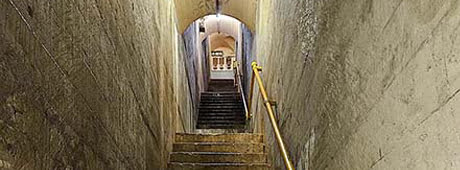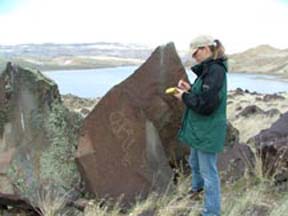No products in the cart.
These Walls Talk

Markings Deep within a Dam
Story and Photos by Jennifer Rilk
As I walk toward the doorway, my heartbeat quickens with each step. I am going inside Black Canyon Diversion Dam, a concrete gravity dam near Emmett in Gem County. Entering the dimly lit, tunnel-like passages of such a structure still gives me pause, even though I’ve worked at the Bureau of Reclamation as an archaeologist for more than seventeen years and have entered many dams for work-related purposes. Nevertheless, part of me still hesitates at the threshold of each one.
I balk not because I have little faith in the dam’s construction. Dams have been built and maintained across the western United States for more than 120 years and in the process, construction methods and safety measures have been created for these behemoth concrete structures that put my survival instinct at ease. Plus, I’m accompanied by one of the facility’s highly experienced personnel—and I don’t want to look like a wimp. I think my qualms come from something more primal than reason.
When I cross from the natural sunshine into the artificial darkness of the dam’s interior, I take a deep breath, because I am suddenly small and out of my element. The pressure the dam is under from holding back millions of gallons of water is both impressive and daunting, even though I trust the knowledge, math, and materials of the engineers who created it almost a hundred years ago.
But I’m no longer a confident intellectual being. Inside a dam, where it’s dank and loud from rumbling generators being spun by powerful currents of rushing water, there is a distinctly subterranean feel. I’m now just a hapless biped making my way through smooth-arched passages better suited to giant mice. It is obvious as I proceed into the lower drum gate gallery that it was not built for human comfort.
And yet, as we walk to the upper drum gate gallery via a narrow concrete stairway, I’m surrounded by signs of human activity unrelated to the dam’s construction. The walls of the stairway are covered in writing. Signatures, poems, place names and dates, many of them faded from age and environmental conditions, provide testimony to our species’ timeless need to leave its mark wherever it goes.
This content is available for purchase. Please select from available options.
Register & Purchase Purchase Only
Register & Purchase Purchase Only


One Response to These Walls Talk
Alice Dunn -
at
Classy article. I enjoyed reading it very much. Rilke is a good writer and is generous to share her professional observations.